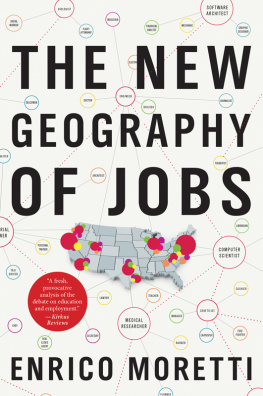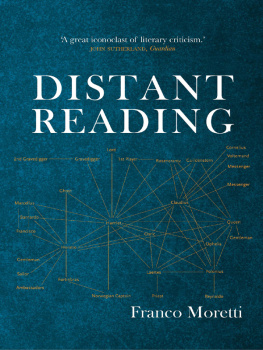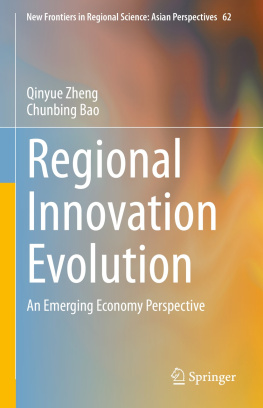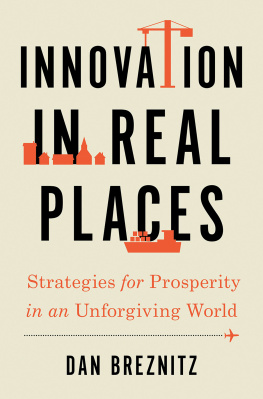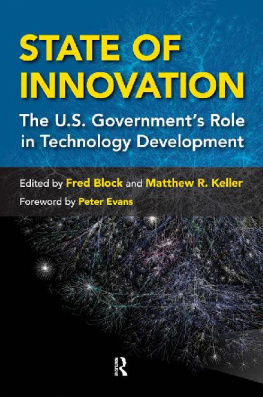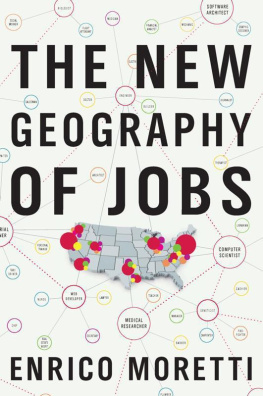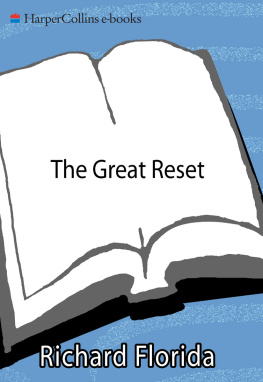First Mariner Books edition 2013
Copyright 2012 by Enrico Moretti
All rights reserved
For information about permission to reproduce selections from this book, write to Permissions, Houghton Mifflin Harcourt Publishing Company, 215 Park Avenue South, New York, New York 10003.
www.hmhbooks.com
Library of Congress Cataloging-in-Publication Data
Moretti, Enrico.
The new geography of jobs / Enrico Moretti.
p. cm.
Includes bibliographical references and index.
ISBN 978-0-547-75011-8
ISBN 978-0-544-02805-0 (pbk.)
1. Labor marketUnited States. 2. Economic developmentUnited States. 3. EqualityUnited States. 4. Technological innovationsEconomic aspectsUnited States. I. Title.
HD5706.M596 2012
331.10973dc23 2012007933
eISBN 978-0-547-75014-9
v2.0313
To Ilaria
Introduction
Menlo park is a lively community in the heart of Silicon Valley, just minutes from Stanford Universitys manicured campus and many of the Valleys most dynamic high-tech companies. Surrounded by some of the wealthiest zip codes in California, its streets are lined with an eclectic mix of midcentury ranch houses side by side with newly built mini-mansions and low-rise apartment buildings. In 1969, David Breedlove was a young engineer with a beautiful wife and a house in Menlo Park. They were expecting their first child. Breedlove liked his job and had even turned down an offer from Hewlett-Packard, the iconic high-tech giant in the Valley. Nevertheless, he was considering leaving Menlo Park to move to a medium-sized town called Visalia. About a three-hour drive from Menlo Park, Visalia sits on a flat, dry plain in the heart of the agricultural San Joaquin Valley. Its residential neighborhoods have the typical feel of many Southern California communities, with wide streets lined with one-story houses, lawns with shrubs and palm trees, and the occasional backyard pool. Its hot in the summer, with a typical maximum temperature in July of ninety-four degrees, and cold in the winter.
Breedlove liked the idea of moving to a more rural community with less pollution, a shorter commute, and safer schools. Menlo Park, like many urban areas at the time, did not seem to be heading in the right direction. In the end, Breedlove quit his job, sold the Silicon Valley house, packed, and moved the family to Visalia. He was not the only one. Many well-educated professionals at the time were leaving cities and moving to smaller communities because they thought those communities were better places to raise families. But things did not turn out exactly as they expected.
In 1969, both Menlo Park and Visalia had a mix of residents with a wide range of income levels. Visalia was predominantly a farming community with a large population of laborers but also a sizable number of professional, middle-class families. Menlo Park had a largely middle-class population but also a significant number of working-class and low-income households. The two cities were not identicalthe typical resident of Menlo Park was somewhat better educated than the typical resident of Visalia and earned a slightly higher salarybut the differences were relatively small. In the late 1960s, the two cities had schools of comparable quality and similar crime rates, although Menlo Park had a higher incidence of violent crime, especially aggravated assault. The natural surroundings in both places were attractive. While Menlo Park was close to the Pacific Ocean beaches, Visalia was near the Sierra Nevada range and Sequoia and Kings Canyon National Parks.
Today the two places could not be more different, but not in the way David Breedlove envisioned. The Silicon Valley region has grown into the most important innovation hub in the world. Jobs abound, and the average salary of its residents is the second highest in America. Its crime rate is low, its school districts are among the best in the state, and the air quality is excellent. Fully half of its residents have a college degree, and many have a PhD, making it the fifth best educated urban area in the nation. Menlo Park keeps attracting small and large high-tech employers, including most recently the new Facebook headquarters.
By contrast, Visalia has the second lowest percentage of college-educated workers in the country, almost no residents with a postgraduate degree, and one of the lowest average salaries in America. It is the only major city in the Central Valley that does not have a four-year college. Its crime rate is high, and its schools, structurally unable to cope with the vast number of non-English-speaking students, are among the worst in California. Visalia also consistently ranks among American cities with the worst pollution, especially in the summer, when the heat, traffic, and fumes from farm machines create the third highest level of ozone in the nation.
Not only are the two communities different, but they are growing more and more different every year. For the past thirty years, Silicon Valley has been a magnet for good jobs and skilled workers from all over the world. The percentage of college graduates has increased by two-thirds, the second largest gain among American metropolitan areas. By contrast, few high-paying jobs have been created in Visalia, and the percentage of local workers with a college degree has barely changed in thirty yearsone of the worst performances in the country.
For someone like David Breedlove, a highly educated professional with solid career options, choosing Visalia over Menlo Park was a perfectly reasonable decision in 1969. Today it would be almost unthinkable. Although only 200 miles separate these two cities, they might as well be on two different planets.
The divergence of Menlo Park and Visalia is not an isolated case. It reflects a broader national trend. Americas new economic map shows growing differences, not just between people but between communities. A handful of cities with the right industries and a solid base of human capital keep attracting good employers and offering high wages, while those at the other extreme, cities with the wrong industries and a limited human capital base, are stuck with dead-end jobs and low average wages. This divideI will call it the Great Divergencehas its origins in the 1980s, when American cities started to be increasingly defined by their residents levels of education. Cities with many college-educated workers started attracting even more, and cities with a less educated workforce started losing ground. While in 1969 Visalia did have a small professional middle class, today its residents, especially those who moved there recently, are overwhelmingly unskilled. Menlo Park had many low-income families in 1969, but today most of its new residents have a college degree or a masters degree and a middle- to upper-class income. Geographically, American workers are increasingly sorting along educational lines. At the same time that American communities are desegregating racially, they are becoming more segregated in terms of schooling and earnings.
Certainly any country has communities with more or less educated residents. But today the difference among communities in the United States is bigger than it has been in a century. The divergence in educational levels is causing an equally large divergence in labor productivity and therefore salaries. Workers in cities at the top of the list make about two to three times more than identical workers in cities at the bottom, and the gap keeps growing.
Cities with a high percentage of skilled workers offer high wages not just because they have many college-educated residents and these residents earn high wages. This would be interesting but hardly surprising. But something deeper is going on. A workers education has an effect not just on his own salary but on the entire community around him. The presence of many college-educated residents changes the local economy in profound ways, affecting both the kinds of jobs available and the productivity of every worker who lives there, including the less skilled. This results in high wages not just for skilled workers but for most workers.
Next page
